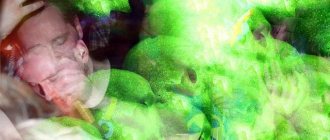| Stupor | |
| Catatonic stupor | |
| ICD-10 | [apps.who.int/classifications/icd10/browse/2010/en#/R40.1 40.1]40.1 |
| ICD-9 | [www.icd9data.com/getICD9Code.ashx?icd9=780.09 780.09]780.09 |
| MeSH | D053608 |
Stupor
(from Latin
stupor
“numbness, stupor”) - in psychiatry, one of the types of movement disorder, which is complete immobility with mutism and weakened reactions to irritation, including pain.
There are various types of stuporous states:
- catatonic,
- reactive,
- depressive,
- manic stupor.
Catatonic stupor
occurs most often K: Wikipedia: Articles without sources (type: not specified) [
source not specified 1874 days
], it develops as a manifestation of the catatonic syndrome and is characterized by passive negativism or waxy flexibility or (in the most severe form) severe muscle hypertension with the patient’s numbness in pose with bent limbs.
Being in a stupor, patients do not come into contact with others, do not react to current events, various inconveniences, noise, wet and dirty bed. They may not move if there is a fire, earthquake or some other extreme event. Patients usually lie in one position, the muscles are tense, the tension often begins with the masticatory muscles, then goes down to the neck, and later spreads to the back, arms and legs. In this state, there is no emotional or pupillary response to pain. Bumke's sign—dilation of the pupils in response to pain—is absent.
In stupor with waxy flexibility
In addition to mutism and immobility, the patient maintains the given position for a long time, freezes with a raised leg or arm in an uncomfortable position. Pavlov's symptom is often observed: the patient does not respond to questions asked in a normal voice, but responds to whispered speech. At night, such patients can get up, walk, put themselves in order, sometimes eat and answer questions.
Negativistic stupor
characterized by the fact that with complete immobility and mutism, any attempt to change the patient’s position, lift him or turn him over causes resistance or opposition. It is difficult to get such a patient out of bed, but once raised, it is impossible to put him back down. When trying to be brought into the office, the patient resists and does not sit down on the chair, but the seated person does not get up and actively resists. Sometimes active negativism is added to passive negativism. If the doctor extends his hand, he hides his hand behind his back, grabs food when it is about to be taken away, closes his eyes when asked to open, turns away from the doctor when asking him a question, turns and tries to speak when the doctor leaves, etc.
Stupor with muscle numbness
characterized by the fact that patients lie in the intrauterine position, muscles are tense, eyes are closed, lips are extended forward (proboscis symptom). Patients usually refuse to eat and have to be fed through a tube or undergo amytalcaffeine disinhibition and feed at a time when the manifestations of muscle numbness decrease or disappear.
For depressive stupor
with almost complete immobility, patients are characterized by a depressed, pained expression on their face. You manage to make contact with them and get a monosyllabic answer. Patients in a depressive stupor are rarely untidy in bed. Such a stupor can suddenly give way to an acute state of excitement - melancholic raptus, in which patients jump up and injure themselves, can tear their mouths, tear out an eye, break their heads, tear their underwear, and can roll on the floor howling. Depressive stupor is observed in severe endogenous depression.
In apathetic stupor
patients usually lie on their backs, do not react to what is happening, and muscle tone is reduced. Questions are answered in monosyllables with a long delay. When contacting relatives, the reaction is adequate emotional. Sleep and appetite are disturbed. They are untidy in bed. Apathetic stupor is observed with prolonged symptomatic psychoses, with Gaye-Wernicke encephalopathy.
Links
Wiktionary has an entry for "stupor"
| : Incorrect or missing image | To improve this article on medicine, it is advisable to:
|
Treatment of stupor
Many people are concerned about the question: “how to get out of the stupor”? Naturally, only specialists - psychotherapists and psychologists - can help with this. However, you should still know how to help a loved one or someone around you if signs become noticeable that the subject is about to fall into a stupor or has already entered such a state and needs help.
So, first of all, massage of special points located exactly in the middle above the pupils, equidistant from the eyebrow arches and hairline, will help relieve tension. These points should be massaged using the pads of the index finger and thumb. In addition, it is recommended to try to provoke strong emotions in an individual in a stuporous state, no matter positive or negative (preferably negative). For example, you can slap someone in the face.
It can help to get out of the stupor by bending the individual’s fingers and pressing them forcefully against the palms, while the thumbs remain straight. So, the answer to the question: “how to get out of a stupor” is hidden in the emotional shake-up of the body and the synchronization of the breathing of the sufferer with the subject helping him. For this purpose, you can put your hand on the chest of an individual who has fallen into a stupor and adjust to his breathing pace.
https://www.youtube.com/watch?v=upload
In case of stupor, emergency care is limited to ensuring the safety of subjects and preventing dangerous actions on their part. For example, in a catatonic stuporous state, emergency assistance will consist of readiness to stop unexpected impulsive agitation.
In case of depressive stupor - preventing the possibility of unexpected development of depressive agitation with a focus on suicide, as well as eliminating food refusal. In addition, you need to take into account that stupor can suddenly give way to excitement.
Treatment often occurs in an inpatient setting. Barbamyl-caffeine disinhibition is used. Thanks to which it is possible to detect the characteristics of the patient’s experiences and anxieties, which helps to determine the nature of the stuporous state. This disinhibition is also a therapeutic method that helps with persistent food refusal.
A stuporous state that occurs against the background of severe somatic illnesses requires treatment of the underlying disease.
For stupor accompanied by hallucinations and delusions, Stelazine and Trisedal are used as well as in the treatment of hallucinatory and delusional states. In case of a depressive stuporous state, disinhibition is also carried out and Melipramin is used up to 300 mg per day orally or intramuscularly. For a psychogenic stuporous state - Diazepam up to 30 mg per day orally or intramuscularly, Elennium or Phenazepam.
Excerpt characterizing Stupor
- Where is it? “Over there, in Echkino,” said the Cossack officer, pointing to a distant landowner’s house. - What’s it like there, behind the chain? - They sent two of our regiments into a chain, there is such a revelry going on there now, it’s a disaster! Two musics, three choirs of songwriters. The officer went behind the chain to Echkin. From afar, approaching the house, he heard the friendly, cheerful sounds of a soldier's dancing song. “In the meadows, ah... in the meadows!..” - he heard him whistling and clanking, occasionally drowned out by the shouting of voices. The officer felt joyful in his soul from these sounds, but at the same time he was afraid that he was to blame for not transmitting the important order entrusted to him for so long. It was already nine o'clock. He dismounted from his horse and entered the porch and entrance hall of a large, intact manor house, located between the Russians and the French. In the pantry and in the hallway footmen were bustling around with wines and dishes. There were songbooks under the windows. The officer was led through the door, and he suddenly saw all the most important generals of the army together, including the large, noticeable figure of Ermolov. All the generals were in unbuttoned frock coats, with red, animated faces and were laughing loudly, standing in a semicircle. In the middle of the hall, a handsome short general with a red face was smartly and deftly making a thrasher. - Ha, ha, ha! Oh yes Nikolai Ivanovich! ha, ha, ha!.. The officer felt that by entering at that moment with an important order, he was being doubly guilty, and he wanted to wait; but one of the generals saw him and, having learned what he was for, told Ermolov. Ermolov, with a frowning face, went out to the officer and, after listening, took the paper from him without telling him anything. - Do you think he left by accident? - a staff comrade said to a cavalry officer about Ermolov that evening. - These are things, it’s all on purpose. Give Konovnitsyn a ride. Look, what a mess it will be tomorrow! The next day, early in the morning, the decrepit Kutuzov got up, prayed to God, got dressed, and with the unpleasant consciousness that he had to lead a battle that he did not approve of, got into a carriage and drove out of Letashevka, five miles behind Tarutin, to the place where the advancing columns were to be assembled. Kutuzov rode, falling asleep and waking up and listening to see if there were any shots on the right, if things were starting? But everything was still quiet. The dawn of a damp and cloudy autumn day was just beginning. Approaching Tarutin, Kutuzov noticed cavalrymen leading their horses to water across the road along which the carriage was traveling. Kutuzov took a closer look at them, stopped the carriage and asked which regiment? The cavalrymen were from the column that should have been far ahead in ambush. “It might be a mistake,” thought the old commander-in-chief. But, having driven even further, Kutuzov saw infantry regiments, guns in their boxes, soldiers with porridge and firewood, in underpants. An officer was called. The officer reported that there was no order to move. “How could you not...” Kutuzov began, but immediately fell silent and ordered the senior officer to be called to him. Having got out of the carriage, with his head down and breathing heavily, silently waiting, he walked back and forth. When the requested General Staff officer Eichen appeared, Kutuzov turned purple, not because this officer was guilty of a mistake, but because he was a worthy subject for expressing anger. And, shaking, gasping for breath, the old man, having entered into that state of rage into which he was able to enter when he was rolling on the ground in anger, he attacked Eichen, threatening with his hands, shouting and swearing in vulgar words. Another person who turned up, Captain Brozin, who was innocent of anything, suffered the same fate. - What kind of rascal is this? Shoot the scoundrels! – he shouted hoarsely, waving his arms and staggering. He was in physical pain. He, the commander-in-chief, the most illustrious, whom everyone assures that no one has ever had such power in Russia as he does, he is put in this position - ridiculed in front of the entire army. “It was in vain that I bothered so much to pray about this day, in vain I did not sleep at night and thought about everything! - he thought about himself. “When I was an officer as a boy, no one would have dared to make fun of me like that... But now!” He experienced physical suffering, as from corporal punishment, and could not help but express it with angry and painful cries; but soon his strength weakened, and he, looking around, feeling that he had said a lot of bad things, got into the carriage and silently drove back.
Symptoms of stupor
Being in a stupor, people do not contact the environment, they do not have reactions to ongoing events or uncomfortable conditions, various inconveniences (for example, noise, dirty bed).
Patients in a stupor may not move even during a fire, earthquake or other natural disaster. They often lie without changing position, the muscles are in good shape. Typically, tension begins in the masticatory muscles, then moves down to the cervical region, and later spreads to the back, arms and legs. In this state, there is no emotional and pupillary response to pain.
Symptoms of stupor include: clouding of consciousness, absolute immobility, partial or complete silence (mutism), increased muscle tone, negativism, depressed reflex reactions, lack of verbal communication with others and lack of response to external stimuli.
Falling into an emotional stupor is more typical of the female part of the population. Emotional stupor often occurs as a result of intense mental shock (for example, experienced horror or grief). It is characterized by a blocking of motor activity and emotional-affective activity; in addition, the mental function also slows down.
A stuporous state of this type can be observed in women who have witnessed some kind of catastrophe or accident. Stupor may also occur in children as a result of taking exams or during battle in soldiers.
Depressive stupor is characteristic equally of the female part of the population and the stronger half of humanity. It occurs against the background of deep depression and, as a rule, is accompanied by a hunched posture, a grimace of suffering on the face of the subjects, and a downcast gaze. Patients in this condition may respond to interrogative statements with monosyllabic phrases in a whisper.
Overly receptive, emotional, vulnerable people and creative individuals characterized by a subtle internal organization are characterized by mental stupor. It is expressed in the form of apathy, laziness, melancholy, creative crisis, inability to think, feel and inability to act differently. In this state, a kind of mental “ossification” occurs.
Hysterical stupor is more often observed in overly emotional women. It usually manifests itself as affective inconstancy, the cause of which may be a changed environment. This type of stuporous state in difficult conditions that threaten the health, life or well-being of a woman can represent a defensive reaction.
Apathetic stupor manifests itself in passivity and immobility, lack of aspirations and interests.
Why do we fall into a stupor when excited and how to avoid it
A famous golfer misses a critical hole; a smart student fails a test; An experienced salesperson misses a great opportunity. Each of these people suffered from the same psychological problem: they fell into a stupor under the pressure of circumstances.
It’s tempting to chalk these failures up to “just nerves.” But University of Chicago psychologist Shawn Beilock has found that they are a consequence of preventable information blockages in the brain. By studying the behavior of the brain at the limit - when we are at the top and when we are in a stupor, Beilock formulated practical recommendations that allow us not to give up slack even in critical situations.
Based on this research, Beilock released a new book, Choke: What the Secrets of the Brain Reveal About Getting it Right When You Have To.
“Stupid is suboptimal performance, not just poor performance. This is the performance of a task at a lower level than in the past, under the pressure of a stressful situation. This can happen if you feel pressure to get everything right,” said Beilock, an associate professor of psychology.
In the case of high performance sports, stupor can lead to the fact that movements performed repeatedly will not work.
Thinking too hard about what exactly you need to do, due to anxious thoughts about losing your leadership position (in the case of athletes) or worry about possible failure in general, can lead to “paralysis by analysis.” Essentially, paralysis by analysis occurs when a person tries to control every aspect of their actions in an attempt to achieve success. Unfortunately, this increased control can be counterproductive, having a destructive effect on once smooth and flawless performance.
“My research team and I found that professional golfers were more likely to hit the hole-in-one if we provided them with techniques to stop analyzing their swing, to stop thinking,” Beilock said. “Strokes that are polished to the point of automaticity work better if you don’t try to control everything down to the smallest detail.”
Beilock's research has shown that even something as simple as singing can distract the parts of the brain that interfere with the task. Whistling can help at work. “If your performance has become automatic and you've done it a thousand times in the past, a small distraction like whistling can help relieve tension.”
The brain can sabotage you through more than just analysis paralysis. For example, tension can occupy all of the brain's processing resources known as working memory, which is critical in everyday life.
Training under stress, even moderate stress, helps a person feel comfortable in a real situation.
Also, anxiety can be overcome by thinking about what to do or say rather than what not to do or say.
“Don’t worry about the outcome, enjoy the process,” Beilock advised. “Remind yourself that you have the necessary skills and are in control of the situation.”
Original (in English): News.uchicago
Causes:
- decreased blood glucose levels (hypoglycemia);
- increased blood glucose levels (hyperglycemia);
- increased sodium levels in the blood (hypernatremia);
- decreased sodium levels in the blood (hyponatremia);
- low blood pressure;
- renal failure;
- brain disease;
- trauma (especially to the head or brain);
- infections (viral, bacterial, parasitic, fungal);
- drugs that lead to loss of consciousness;
- unknown causes (idiopathic);
- immune-related diseases (the immune system overreacts or attacks the body);
- chemical or drug poisoning.








